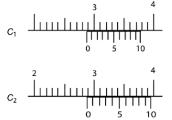
Answer
455.7k+ views
Hint: A vernier calliper is a measuring instrument consisting of a main scale with a fixed jaw and a moving jaw with a vernier attached. Here we have to first find the vernier scale division and then the main scale division to calculate the reading.
Complete step by step answer:
The vernier calliper least count function is determined by dividing the smallest reading of the main scale by the total number of vernier scale divisions.
For any form of scale the least count is an important determining parameter. Least count of vernier callipers is the difference between one smallest main scale reading and one smallest vernier scale reading which is $0.1\,mm$ or $0.01\,cm$. The least count is therefore important since it is specifically related to an instrument’s precision, and in some situations precision and least count are used interchangeably while they have separate definitions.
For a calliper if the least count is known, then we can use the following formula to conveniently find any length-
Length=MSR + (VSR×L.C)
Where MSR=main scale reading
VSR=Vernier scale reading and
L.C= least count
Now we can find the solution-
MSD $ = \dfrac{1}{{10}}\,cm = 0.1\,cm$
For first vernier calliper, $10$ VSD $ = 9$ MSD
VSD $ = \dfrac{9}{{10}}$
MSD $ = 0.9 \times 0.1 = 0.09\,cm$
Reading = main scale reading up to coinciding main scale division $ - n \times $ VSD = $3.5 - 7 \times 0.09 = 3.5 - 0.63 = 2.87\,cm$
For second vernier calliper, $10$ VSD$ = 11$ MSD
VSD $ = \dfrac{{11}}{{10}}$
MSD $ = 1.1 \times 0.1 = 0.11\,cm$
Reading $ = 3.6 - 7 \times 0.11 = 3.6 - 0.77 = 2.83\,cm$
Hence, option (B) is the correct answer.
Note:While taking reading on a vernier scale we should check the alignment of the main scale and the vernier scale. There may still be error due to the human eye. So, the main scale reading formula helps in overcoming these errors and least count helps in overcoming these errors.
Complete step by step answer:
The vernier calliper least count function is determined by dividing the smallest reading of the main scale by the total number of vernier scale divisions.
For any form of scale the least count is an important determining parameter. Least count of vernier callipers is the difference between one smallest main scale reading and one smallest vernier scale reading which is $0.1\,mm$ or $0.01\,cm$. The least count is therefore important since it is specifically related to an instrument’s precision, and in some situations precision and least count are used interchangeably while they have separate definitions.
For a calliper if the least count is known, then we can use the following formula to conveniently find any length-
Length=MSR + (VSR×L.C)
Where MSR=main scale reading
VSR=Vernier scale reading and
L.C= least count
Now we can find the solution-
MSD $ = \dfrac{1}{{10}}\,cm = 0.1\,cm$
For first vernier calliper, $10$ VSD $ = 9$ MSD
VSD $ = \dfrac{9}{{10}}$
MSD $ = 0.9 \times 0.1 = 0.09\,cm$
Reading = main scale reading up to coinciding main scale division $ - n \times $ VSD = $3.5 - 7 \times 0.09 = 3.5 - 0.63 = 2.87\,cm$
For second vernier calliper, $10$ VSD$ = 11$ MSD
VSD $ = \dfrac{{11}}{{10}}$
MSD $ = 1.1 \times 0.1 = 0.11\,cm$
Reading $ = 3.6 - 7 \times 0.11 = 3.6 - 0.77 = 2.83\,cm$
Hence, option (B) is the correct answer.
Note:While taking reading on a vernier scale we should check the alignment of the main scale and the vernier scale. There may still be error due to the human eye. So, the main scale reading formula helps in overcoming these errors and least count helps in overcoming these errors.
Recently Updated Pages
10 Examples of Evaporation in Daily Life with Explanations

10 Examples of Diffusion in Everyday Life

1 g of dry green algae absorb 47 times 10 3 moles of class 11 chemistry CBSE

What is the meaning of celestial class 10 social science CBSE

What causes groundwater depletion How can it be re class 10 chemistry CBSE

Under which different types can the following changes class 10 physics CBSE

Trending doubts
Fill the blanks with the suitable prepositions 1 The class 9 english CBSE

Which are the Top 10 Largest Countries of the World?

How do you graph the function fx 4x class 9 maths CBSE

Differentiate between homogeneous and heterogeneous class 12 chemistry CBSE

Difference between Prokaryotic cell and Eukaryotic class 11 biology CBSE

Change the following sentences into negative and interrogative class 10 english CBSE

The Equation xxx + 2 is Satisfied when x is Equal to Class 10 Maths

Why is there a time difference of about 5 hours between class 10 social science CBSE

Give 10 examples for herbs , shrubs , climbers , creepers





